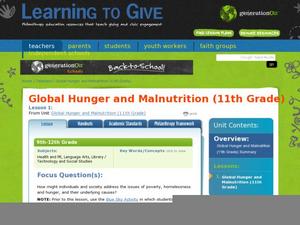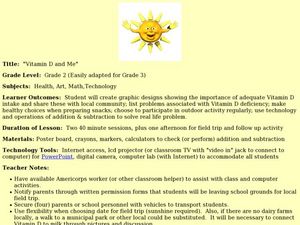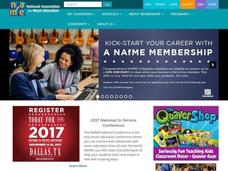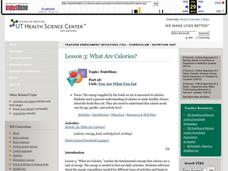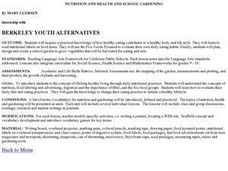Curated OER
Nutrition: Gregory the Terrible Eater
Young scholars listen to a story about a goat who craves human food. They discover the four basic food groups and discuss what they might eat if they were terrible eaters. Students retell the story by looking at the pictures. They...
Curated OER
Put a Rainbow on Your Plate
In this nutrition worksheet, students investigate the importance of eating fruits and vegetables of different colors 5 times a day. Students complete 8 pages of activities such as menu planning, shopping lists, word search, word...
Curated OER
Early Childhood Nutrition
Students complete activities that focus on food and nutrition. In this food lesson plan, students sort foods into healthy and not healthy, categorize them into ground and tree sorts, draw their favorite foods, make abc books of food, and...
Curated OER
Rainbow Milk
Students complete activities to learn about rainbows and the importance of dairy in their diet. In this sense and diet lesson, students discuss rainbow colors, the importance of sight, and the importance of dairy in a healthy diet....
Curated OER
Eating Well and Keeping Fit
Learners look at statistics that show children who are overweight are increasing in our society. Students chart out ways to be physically active and how to eat a balanced diet. Learners devise a menu/activity chart in light of what has...
Curated OER
How History Changed the Way We Eat
Students participate in a lesson that is concerned with the history of the food pyramid and how it evolved and changed into its modern state. After being presented with the information they conduct classroom discussions about the research.
Curated OER
Pyramid Play
Students investigate the concept of the Food Pyramid. They use a game as a tool of discovery in order to classify different types of food in the pyramid. Upon completion of the game the students construct their own models of it.
Curated OER
Brown Bagging It
Students analyze brown bag lunches and choose appropriate foods to make a nutritious balanced meal. They examine the calorie and nutrient content of the chosen meal and modify the contents as necessary.
Curated OER
BMI: Body Mass Indicator
Students discover their body weight and composition. In this health lesson, students use a body mass indicator to identify their percentage of body fat. Students develop an exercise plan and record progress throughout a month.
Curated OER
Global Hunger and Malnutrition
Is there a difference between hunger and malnutrtion? Is this a problem only in third world countries? How does hunger and malnutrition affect the community? Why do these problems exist when the world produces enough food to feed...
Curated OER
Vitamin D and Me
Students create a graphic organizer showing the importance of Vitamin D intake. In this Vitamin D instructional activity, Students list problems with Vitamin D deficiency and create poster boards in small groups. Individually, students...
Curated OER
Asthma and Allergies
Your health class reads two biographical stories: one about a girl who has allergies and the other about a girl who has asthma. They watch a quick cartoon on the KidsHealth website about immunity and take the related online quiz. You...
Curated OER
Staying Healthy Year Round
Students are read a variety of books and observe the weather in the different seasons. In groups, they compare and contrast the type of activities people are doing. They also discuss how they adapt to the changes in seasons by the...
Curated OER
Plate and Planet
Students investigate the health hazards of modern agriculture and how we can choose better food options. In this healthy eating lesson, students identify different indigenous people in photographs and discuss what they might eat....
Curated OER
Fit Kid
Learners practice and perform the song "Fit Kid" while learning the basics of motion and music and dynamics in this elementary-level lesson for the General Music classroom. The lesson emphasizes proper exercise and diet for a healthy life.
Curated OER
What Are Calories?
Students examine calories for the human body. In this calorie instructional activity, students explore the energy expenditures needed for different types of activities and how many calories are needed to support daily functions.
Curated OER
Munching on Mixtures
Students predict, observe, and record what grasshoppers eat to demonstrate an understanding that grasshoppers and people have nutritional requirements to grow and maintain good health.
Curated OER
Try Something New! Enjoy the Great Taste of Whole Grains
Students share their shopping experience with the new WIC whole grain check. In this adult health lesson, students explain the proper way to prepare whole grains. They watch a cooking demo on a new recipe and implement it at home.
Education Outside
What Are Grains?
This activity is like having a show-and-tell. Bring in lots of items, or packaging, from the grain group. Bread, rice, cracker, cereal, oats, you get the idea. Perhaps first start by checking in and asking what the class knows about...
Curated OER
Rate Your Family's Plate
Students examine their family's eating habits. In this adult health lesson, students share what they think from the survey facts presented to them. They set a goal for their family's health.
Curated OER
Eating for Health
Students examine their family's eating habits. In this adult health lesson, students discuss changes they plan to make in their family. They observe how hopscotch is played and try to do this at home.
Curated OER
Feeding is Parenting
Students examine their kid's eating habits. In this adult health lesson, students discuss ways to help their kids eat well. They read a book about positive feeding relationship and apply it at home.
Curated OER
Behavior Assessment & Nutrient Needs
Students identify the factors that influence eating behaviors. They discover the nutrients that are needed in a teenager's body. They also identify the major food groups and examine the food pyramid.
Curated OER
Nutrition and Health and School Gardening
Students examine how healthy eating contributes to a healthy body and life style. They read nutritional labels on food items. They use the Five Foods Pyramid to evaluate their own eating habits. They plan, design, and create a school...











